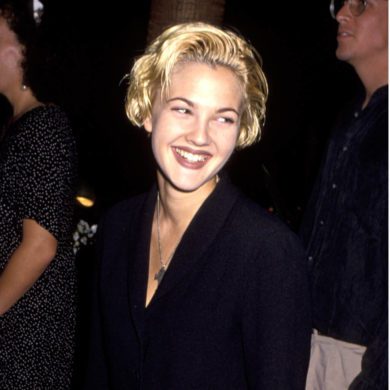Every evening, Laura follows a particular series of rituals to help her wind down before bed. There’s the usual stuff – cleansing her face, moisturising and pulling a brush through her hair – and then there’s the regimen she has developed over the last few months of living alone. Checking the windows and dead bolts on the doors, casting a final glance over the CCTV monitors next to her TV, and ensuring the red bucket of water by her bed is full.
These are all hallmarks of an anxious person, but Laura isn’t naturally a worrier. She’s just following the advice of domestic violence experts, who fear her ex-boyfriend will try to burn down the house around her while she sleeps (hence the bucket). According to the specialist assessment of her case, Laura is at “extremely high risk of ex-partner death.”
“It’s like living in a scary movie,” she says. “Knowing that somebody I loved and spent some of the most intimate moments and memories with is capable of those horrors.”
Although he’s repeatedly broken the Apprehended Domestic Violence Order (ADVO) issued against him last year, Laura’s ex-partner Andrew has not been charged and police, while sympathetic, are powerless to do more to protect her. So for now, she is just sitting tight, and waiting. Waiting for the harassment to stop or, worse, for him to act. Still, as she says wryly: “At least I’ve got a bucket of water.”
Laura is at ‘high risk of ex-partner death’
As we all know, Laura’s story is frighteningly common. In fact the statistics on family violence are repeated so frequently in the media that sometimes it seems we’re in danger of becoming inured to them. One in six Australian women has experienced physical or sexual violence by a current or former partner; for emotional abuse, it’s one in four. Intimate partner violence causes more illness, disability and death for Australian women aged 25 to 44 than any other risk factor including car accidents or cancer.
Yet for all the promises of greater funding and all the campaigns raising awareness, women like Laura are still dying at the hands of the men (and they are overwhelmingly men) who said they loved them the most. Knowing one woman a week is killed by a current or former partner is especially strange when you know it could be you. Laura compares it to receiving a cancer diagnosis, with no options to treat or save yourself.
So why do women like Laura continue to feel so powerless? One issue is the difficulty in enforcing ADVOs, which has been a problem for years because the burden of proof is so high. Victims of harassment can find it difficult to demonstrate that an abuser has been stalking them, for example, as they might be the only witness.
“Often it ends up being two competing stories without other evidence,” says family and domestic violence expert Professor Heather Douglas, of the University of Queensland. “And in a context where the burden of proof is ‘beyond reasonable doubt’ it is not then surprising there is no conviction.”
Knowing one woman a week is killed by a current or former partner is especially strange when you know it could be you
But there are other barriers, too, adds psychologist Carmel O’Brien, who cites the inconsistent stalking laws in each state and territory, and the severity of a woman’s experience often being underestimated or disbelieved.
Laura is the first person to admit she never thought she’d be in an abusive relationship. She’s a strong, confident woman in her early thirties, who had a good job and plenty of friends.
At the start she thought Andrew was a nice, normal guy. They’d met at work and he was intensely affectionate from the very start of their relationship. “He told me pretty much straight away: ’You’re my soulmate, you’re the love of my life,’” Laura says. “Every girl wants to hear that.” He shared his hopes and dreams, and asked constantly about her own. He’d steal every chance he could to talk to her. Little wonder she fell in love.
It’s behaviour that experts call “love bombing”, where abusers overwhelm an incipient partner with affection and adoration. It’s why Laura fought so hard for him when he changed, because she remembered how great it was – how happy they’d been, until they weren’t.
Slowly, almost imperceptibly, his behaviour altered. He’d ignore her – simply refuse to speak to her – for days, or he’d police the way she spoke, and refuse to let her leave the room when he screamed at her. If you love someone, he said, you don’t leave. Ever.
“I thought he was just damaged,” says Laura now. “I thought if he felt secure enough he might just stop reacting.” It took her years to realise he didn’t want to be fixed.
She remembered how great it was – how happy they’d been
O’Brien says too often, abusers use a capricious carousel of cruelty and kindness to leave victim-survivors scrambling to fix a relationship – and more often than not, it’s this mental manipulation that does the most damage.
“One way to think about it is this: if intimate partner violence was about physical assault, then most victims would be fine within days or weeks,” she says. “Unfortunately, it is the psychological wounds that take the longest to heal, whether someone is physically injured or not.”
One of the most chilling moments for Laura was the night Andrew’s silent treatment turned to physical fury. After hours of being ignored by him, she started to cry. He grabbed her and pinned her on the bed, punching the pillow next to her.
“He was looking directly into my eyes but it was just black,” she says. “There was no soul left.” At that moment, Laura saw clearly that Andrew had the capacity to hurt her seriously. “There was something so wrong. I’ve never seen it in my life and I never want to see it again.”
Shortly after that she broke it off for good – a month later, she stopped answering all his texts, messages and calls. But that didn’t stop him trying to reach her.
Sometimes her phone would ring 40 times a day. She ignored it, and then switched it to airplane mode. She felt pressured, hyper-vigilant. His behaviour started to become more menacing.
She stopped answering all his texts, messages and calls. But that didn’t stop him trying to reach her
He’d turn up at her house at all hours, pleading to talk, or tail her as she drove, always a few cars behind her – too far to photograph. Once, he broke into her house when she wasn’t home. The phone calls continued. Then one day he turned up at a friend’s party at a restaurant, staring through the windows, obviously agitated. Laura froze in her seat, but a friend saw what was happening, grabbed her hand and pulled her towards the bathrooms. “Move, Laura!” she yelled. “Get up and fucking RUN!”
For the next 20 minutes they stayed in the locked bathroom, until the friend ventured out to see if Andrew had gone. “I was sitting there on the floor and I had no idea what was going on.” Once he’d left, Laura called her counsellor, distraught. The next words, uttered so urgently down the line, still haunt her.
“She said, ‘Laura, you need to listen to me. You need to go to the police. This is when people die. You hear it on the news all the time. This is when people die.’
“She made me promise to go to the police. I said I would but I didn’t. He hadn’t hit me.”
She said, ‘You need to go to the police. This is when people die’
As perverse as it might sound, she still loved him; even now she questions whether she was really abused, after being told for so long that it was her fault, or that she was the one who was unstable. Eventually, though, Laura did secure an ADVO and was placed in a refuge in another city. “[It] was very scary,” she recalls. “I had no idea where I was going, when I would be back, what was going to happen. Did I deserve to be there? [But] it was good, because it gave me some much-needed rest and I could sleep for the first time in weeks, knowing I was safe.
“When I met my first domestic violence worker in person, she was amazing. She didn’t hear everything or the worst. She didn’t have to see bruises to believe me. That was one of the moments that stay with you. Belief and no doubt. It gave me strength.”
Vanessa Hingston is a case worker at Sydney’s Women’s and Girls Emergency Centre (she is not Laura’s support worker). She says not-for-profit organisations like hers are struggling to find enough money to support victim-survivors like Laura, and that in some cases women don’t want to go to crisis accommodation if men are there.
After “years of intermittently or completely under-resourced services”, Domestic Violence New South Wales CEO Moo Baulch agrees, and says the recent election promises from both major parties – $328 from the Coalition and $660m from Labor – are as welcome as they are sorely overdue.
Baulch says the Opposition’s commitment goes a “significant way to meeting the current demand” but that it still wouldn’t meet the funding levels required for adequate crisis, frontline, early intervention and prevention responses.
The Coalition’s pledge, she says, wasn’t anything new and is in fact funding for a previously announced Fourth Action Plan to reduce violence against women and their children.
That plan, argues Carmel O’Brien, isn’t enough. Education in schools and early, meaningful intervention from police and the courts to closely monitor the abuser are two essential pieces missing from the puzzle.
After a week in the refuge Laura returned home, tired and afraid. Her whole neighbourhood now knew her as ‘DV girl’ and she’d lost her job because she couldn’t make it to work. Shame prevented her from telling her family how grave the situation had become, and friends she shared with Andrew were reluctant to get involved. But she remained hopeful the ADVO might finally grant her some peace.
Domestic violence workers didn’t share her optimism. They warned her that she was still very high risk – that she should sell her home, change her name, move interstate. Police, too, admitted it might come to that.
Laura reports each breach of the ADVO to police, but each time the burden of proof is too high. “They say, ‘There’s nothing we can do.’ Just stay safe. Try not to be alone.’”
Shame prevented her from telling her family how grave the situation had become
Professor Douglas says the number of convictions for AVO breaches is higher than ever, but the complex system remains difficult to navigate. The definition of domestic violence itself varies in each state and territory. Queensland and Victoria, she says, are the only states that recognise controlling and coercive behaviour as abuse.
Stalking is a subset of domestic abuse, which requires proof of the perpetrator’s intention, a pattern or repeated behaviour, and in some cases the impact on a victim.
New South Wales Assistant Commissioner Mark Jones APM says police take allegations of suspected domestic violence extremely seriously, and all officers are given specialised training. The rate of legal action for AVO breaches, he says, is over 80 per cent.
However, he admits barriers do exist for frontline police including a lack of reporting, victim-survivors’ unwillingness to attend court if charges are laid, reluctance to report breaches to police and a lack of control over the court’s outcomes, including bail and sentencing.
Laura’s a different person these days. She’s harder, less trusting, and she’s been diagnosed with PTSD. Sessions with her counsellor and a domestic violence support group make her feel less alone.
One thing remains the same, though: she’s still a target.
Andrew is still harassing her, using all the methods he has employed relentlessly for months. Each time, Laura documents what he’s done and hands the details to the police.
More than anything, she says, she wishes she could just turn back time. Be who she was before. Live a normal life, care about normal things.
“I can’t even interact digitally. I can’t have my workplace take photos of me,” she says. “People ask ‘why?’ I say it has got to do with my safety. People stare, wanting more information, confused.
“It makes you feel like you are saying something offensive. So it isolates you.”
A few months ago a woman was killed by her partner in the suburb Laura visits for counselling. “She’s just seen as a photo, people just talk about her like she was some hypothetical thing but she was a real person,” she says. “She had real fears. Imagine how many times she probably spoke up and people were like, ‘No, no, you’re exaggerating; it’s not that bad.’”
Laura is a vivacious, funny, hurricane of a woman. When I ask her why she’s agreed to tell her story, her answer is simple. “If I die, I just want people to talk because… it’s real,” she says. “Sometimes I can’t believe it and I look at the stuff that’s happened to me, it’s horrifying. It’s actually horrifying that someone is capable of doing these things. [People] should not be allowed to treat another human being this way and it just gets brushed under the carpet.”
Her name is Laura and she’s got a bucket full of water. She wants to live, but she’s paralysed by the knowledge she could be tomorrow’s tragic news.
*Laura’s name has been changed.
If you or someone you know is the victim of domestic violence, you can call 1800 RESPECT for advice and help
If you would like to help women who are experiencing domestic violence, you can donate to the Women’s And Girls’ Emergency Centre in Sydney.











No Comments